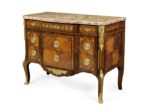In times of inflation, market volatility, and growing uncertainty, investors are turning to tangible assets that offer long-term value and cultural depth. While gold and real estate remain traditional safe havens, antiques – especially fine furniture – are becoming increasingly popular as an alternative investment. But what makes historical furniture such a wise choice?
1. Antiques are tangible, stable assets with intrinsic value
Unlike stocks or cryptocurrencies, which are often influenced by speculation, antiques are real, physical assets with enduring value. 18th and 19th-century French furniture – Louis XV, Empire, or Directoire – offers both historical and aesthetic value. Pieces in original or expertly restored condition can increase significantly in worth over time.
2. A declining market meets steady demand
One key advantage of investing in antiques: They’re finite. Quality antique furniture is no longer produced. With time, many pieces are lost, damaged, or neglected. Meanwhile, there’s growing demand among collectors, interior designers, and culturally aware buyers seeking unique, meaningful objects instead of mass-produced furniture.
3. Sustainable, elegant – and profitable
Antiques represent a sustainable and ethical way of consuming. Buying vintage furniture reduces waste and preserves heritage. At the same time, the fine art and antiques market has shown steady growth, with rare and well-preserved pieces frequently achieving high auction results. When chosen carefully, antique furniture can offer impressive long-term returns.
4. Emotional value meets cultural prestige
Unlike other investments, antiques add daily beauty and inspiration. A Louis XVI commode or hand-carved writing desk offers not just value appreciation, but a living piece of history in your home. This emotional connection is something no stock or bond can replicate.
5. What to consider when buying antiques
For antiques to be a reliable investment, keep in mind:
Authenticity & provenance
Desirable styles & periods (Louis XV, Empire, Biedermeier, etc.)
Condition – original or professionally restored
Craftsmanship & materials – marquetry, bronze mounts, exotic woods
Expert guidance – trust a reputable dealer to avoid costly mistakes
Our Advice at Artliving
At Artliving Vienna, we help clients curate antique collections with long-term value – whether as an investment, for interior design, or both. With decades of experience and a passion for quality, we source only the finest French and European antiques.
👉 Browse our collection at www.artliving.at
📩 Book a private consultation – in-store or online



Leave a Reply